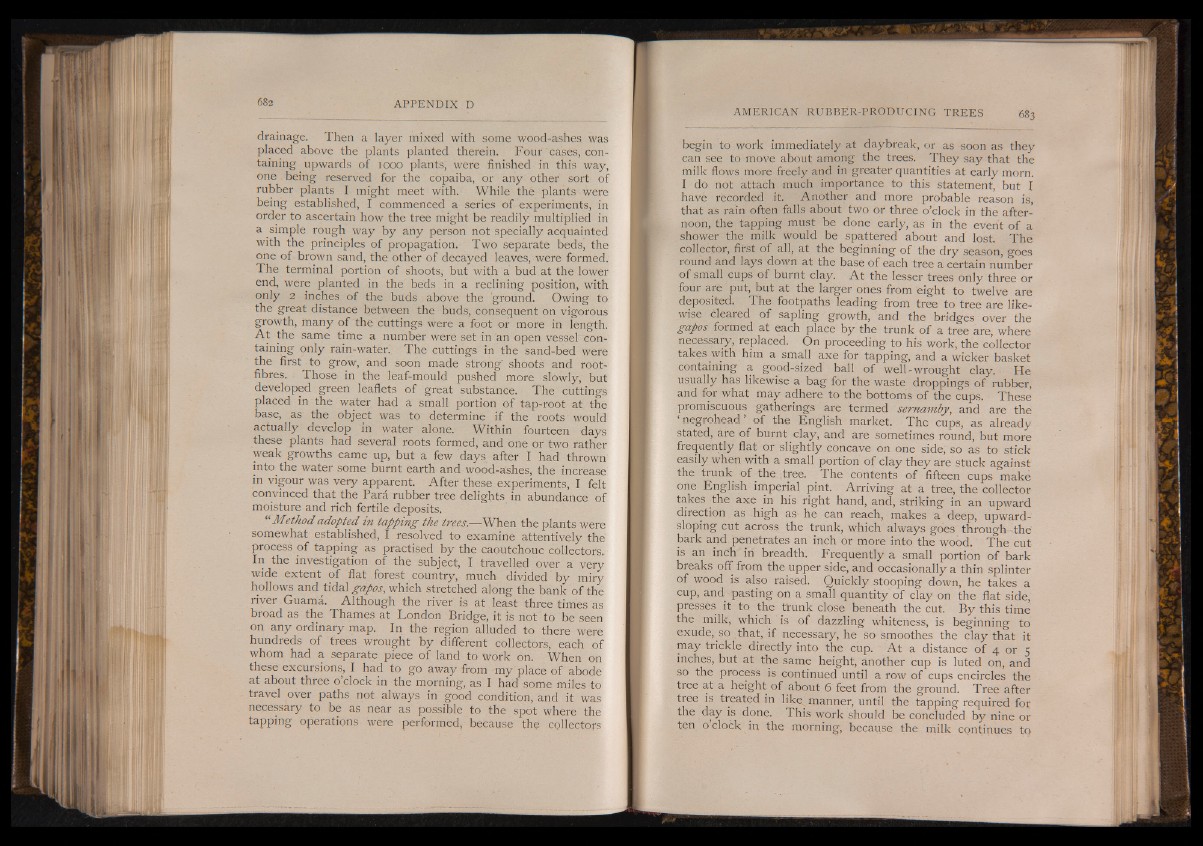
drainage. Then a layer mixed with some wood~ash.es was
placed above the plants planted therein. Four cases, containing
upwards of iooo plants, were finished in this way,
one being reserved for the copaiba, or any other sort of
rubber plants I might meet with. While the plants were
being established, I commenced a series of experiments, in
order to ascertain how the tree might be readily multiplied in
a simple rough way by any person not specially acquainted
with the principles of propagation. Two separate beds, the
one of-brown sand, the other of decayed leaves, were formed.
The terminal portion of shoots, but with a bud at the lower
end, were planted in the beds in a reclining position, with
only 2 inches of the buds above the ground. Owing to
the great distance between the buds, consequent on vigorous
growth, many of the cuttings were a foot or more in length.
A t the same time a number were set in an open vessel containing
only rain-water. The cuttings in the sand-bed were
the first to grow, and soon made strong' shoots and root-
fibres. Those in the leaf-mould pushed more slowly, but
developed green leaflets of great substance. The cuttings
placed in the water had a small portion of tap-root at the
base, as the object was to determine if the roots would
actually develop in water alone. Within fourteen days
these plants had several roots formed, and one or two rather
weak growths came up, but a few days after I had thrown
into the water some burnt earth and wood-a'shes, the increase
in vigour was very apparent. After these experiments, I felt
convinced that the Para rubber tree delights in abundance of
moisture and rich fertile deposits.
“ Method adopted in tapping the trees.— When the plants were
somewhat established, I resolved to examine attentively thé
process of tapping as practised by the caoutchouc collectors.
In the investigation of the subject, I travelled over a very
wide extent of flat forest country, much divided by miry
hollows and tidal gapos, which stretched along the bank of the
river Guama. Although the river is at least three times as
broad as the Thames at London Bridge, it is not to be seen
on any ordinary map. In the region alluded to there were
hundreds of trees wrought by different collectors, each of
whom had a separate piece of land to Work on. When on
these excursions, I had to go away from my place of abode
at about three o’clock in the morning, as I had some miles to
travel over paths not always in good condition, and it was
necessary to be as near as possible to the spot where the
tapping operations were performed, because the collectors
begin to work immediately at daybreak, or as soon as they
can see to move about among the trees. They say that the
milk flows more freely and in greater quantities at early morn.
I do not attach much importance to this statement, but I
have recorded it. Another and more probable reason is,
that as rain often falls about two or three o’clock in the afternoon,
the tapping must be done early, as in the event of a
shower the milk would be spattered about and lost. The
collector, first of all, at the beginning of the dry season, goes
round and lays down at the base of each tree a certain number
of small cups of burnt clay. A t the lesser trees only three or
four are put, but at the larger ones from eight to twelve are
deposited. The footpaths leading from tree to tree are likewise
cleared of sapling growth, and the bridges over the
gapos formed at each place by the trunk of a tree are, where
necessary, replaced. On proceeding to his work, the collector
takes with him a small axe for tapping, and a wicker basket
containing a good-sized ball of well-wrought clay. He
usually has likewise a bag for the waste droppings of rubber,
and for what may adhere to the bottoms of the cups. These
promiscuous gatherings are termed semamby, and are the
‘ negrohead’ of the English market. The cups, as already
stated, are of burnt clay, and are sometimes round, but more
frequently flat or slightly concave on one side, so as to stick
easily when with a small portion of clay they are stuck against
the trunk of the „tree. The contents of fifteen cups make
one English imperial pint. Arriving at a tree, the collector
takes the axe in his right hand, and, striking in an upward
direction as high as he can reach, makes a deep, upward-
sloping cut across the trunk, which always goes through the
bark and penetrates an inch or more into the wood. The cut
is an inch in breadth. Frequently a small portion of bark
breaks off from the upper side, and occasionally a thin splinter
of wood is also raised. Quickly stooping down, he takes a
cup, and pasting on a small quantity of clay on the flat side,
pressés it to the trunk close beneath the cut. By this time
the milk, which is of dazzling whiteness, is beginning to
exude, so that, if necessary, he so smoothes the clay that it
may trickle directly into the cup. A t a distance of 4 or 5
inches, but at the same height, another cup is luted on, and
so the process is continued until a row of cups encircles the
tree at a height of about 6 feet from the ground. Tree after
tree is treated in like manner, until the tapping required for
the day is done. This work should be concluded by nine or
ten o clock in the morning, because the milk continues to